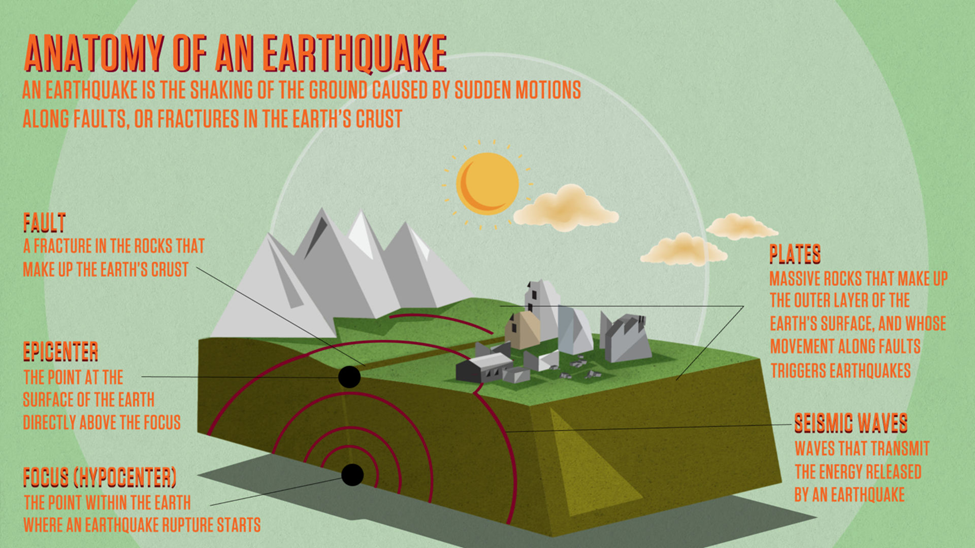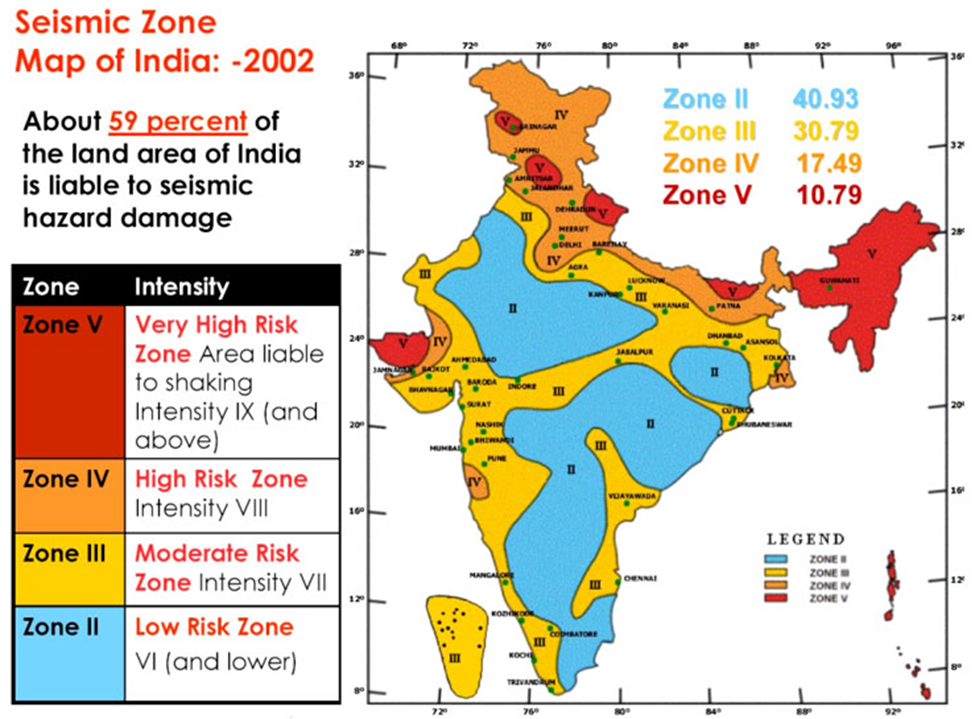What’s in today’s article?
- Why in News?
- What is an Earthquake?
- What are the Earthquake High Risk Zones in India?
- How Big is the Earthquake in Afghanistan?
Why in News?
- Tremors lasting several seconds were felt in Delhi and other parts of North India as a strong 6.5-magnitude earthquake struck Afghanistan recently.
What is an Earthquake?
- An earthquake is an intense shaking of the ground caused by movement under the earth’s surface.
- The location below the earth’s surface where the earthquake starts is called the hypocentre.
- The location directly above the hypocentre on the surface of the earth is called the epicentre.
- It happens when two blocks (tectonic plates) of the earth suddenly slip past one another releasing stored-up ‘elastic strain’ energy in the form of seismic waves.
- These spread through the earth and cause the shaking of the ground.
- They are measured on scales called the –
- Moment Magnitude Scale (Mw), based on the total moment (a product of the distance a fault moved and the force required to move it) release of the earthquake.
- The Richter scale (magnitude scale) – energy released – 0-10.
- The intensity scale/Mercalli scale – visible damage – 1-12.
- Earthquakes continue to remain the most common natural hazard that cannot be predicted as no early warning systems can be developed.
Image Caption: Anatomy of an Earthquake
What are the Earthquake High Risk Zones in India?
- Western Himalayas continue to be one of the most dangerous seismic zones in the world.
- According to the scientists, the Himalayan region – the 2500-km stretch from the Hindu Kush mountains to the end of Arunachal Pradesh – is due for a big earthquake (magnitude of over 8 on Richter scale) anytime.
- This is because of the huge amount of energy stored along the fault lines due to the continuous interaction of different tectonic plates.
- This energy can be released only in the form of massive earthquakes.
Image Caption: Seismic Zone Map of India
How Big is the Earthquake in Afghanistan?
- The earthquake was deep (origin 187.6 km below the earth’s surface) and the epicentre of the earthquake was in northeastern Afghanistan (earthquake prone Hindu Kush region), close to Tajikistan borders.
- Shallow earthquakes are generally more devastating because they carry greater energy when they emerge on the surface.
- Deeper earthquakes lose much of their energy by the time they come to the surface – cause less damage and are more unlikely to be followed by aftershocks.
- However, they spread farther as the seismic waves move radially upwards to the surface.
- That is why the tremors were experienced in Punjab, Rajasthan’s Jaipur, and J&K, however, no damage is reported in India.
- This earthquake was of 6.5-magnitude.
- Magnitude is a measure of how big the waves are, while the strength refers to the energy it carries.
- Magnitude 6 earthquakes have 10 times higher amplitude than magnitude 5 earthquakes. The energy differential is even higher, 32 times for every change of 1 in magnitude.
Q1) What are seismic waves?
Seismic waves are generated by an earthquake or similar energetic source and propagate within the Earth or along its surface. Earthquakes generate body waves (travel within the Earth) and surface waves (travel along its surface).
Q2) What is a seismic shadow zone?
It is an area of the Earth’s surface where seismographs cannot detect direct P waves and/or S waves from an earthquake. This is due to liquid layers or structures within the Earth’s surface.
Source: Afghanistan earthquake shakes north India, aftershocks unlikely | IE
Last updated on December, 2025
→ Check out the latest UPSC Syllabus 2026 here.
→ Join Vajiram & Ravi’s Interview Guidance Programme for expert help to crack your final UPSC stage.
→ UPSC Mains Result 2025 is now out.
→ UPSC Notification 2026 is scheduled to be released on January 14, 2026.
→ UPSC Calendar 2026 is released on 15th May, 2025.
→ The UPSC Vacancy 2025 were released 1129, out of which 979 were for UPSC CSE and remaining 150 are for UPSC IFoS.
→ UPSC Prelims 2026 will be conducted on 24th May, 2026 & UPSC Mains 2026 will be conducted on 21st August 2026.
→ The UPSC Selection Process is of 3 stages-Prelims, Mains and Interview.
→ UPSC Result 2024 is released with latest UPSC Marksheet 2024. Check Now!
→ UPSC Prelims Result 2025 is out now for the CSE held on 25 May 2025.
→ UPSC Toppers List 2024 is released now. Shakti Dubey is UPSC AIR 1 2024 Topper.
→ UPSC Prelims Question Paper 2025 and Unofficial Prelims Answer Key 2025 are available now.
→ UPSC Mains Question Paper 2025 is out for Essay, GS 1, 2, 3 & GS 4.
→ UPSC Mains Indian Language Question Paper 2025 is now out.
→ UPSC Mains Optional Question Paper 2025 is now out.
→ Also check Best IAS Coaching in Delhi



















